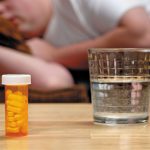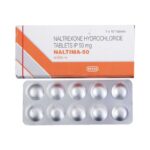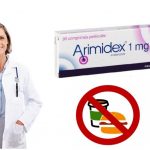What To Avoid When Taking Naltrexone

For most people, taking a new medication may mean switching up your lifestyle a bit and that includes the foods you eat. A food-drug interaction means that a specific nutrient or compound within the food changes the way your body metabolizes the medication, and this can either enhance or reduce the dose your body gets, according to Johns Hopkins Medicine. The potential results: an increased risk of side effects, many of which can be dangerous, or the drug not working as it was intended. Before introducing a medication, ask your pharmacist about any food and drug interactions, including with alcohol, and any adjustments you may have to make to your diet.
What is Naltrexone?
Naltrexone is a medication approved by the Food and Drug Administration (FDA) and used in medication-assisted treatment (MAT) to treat both opioid and alcohol use disorders. It comes in pill form or as an injectable.
The pill form of naltrexone (ReVia, Depade) can be taken at 50 mg once per day. The injectable extended-release form of the drug (Vivitrol) is administered at 380 mg intramuscular once a month.
Naltrexone can be prescribed by any health care provider who is licensed to prescribe medications. To reduce the risk of precipitated withdrawal, patients are warned to abstain from illegal opioids and opioid medication for a minimum of 7-10 days before starting naltrexone. If switching from methadone to naltrexone, the patient has to be completely withdrawn from the opioids.
How Naltrexone Works
Naltrexone blocks the euphoric and sedative effects of drugs such as heroin, morphine, and codeine. It works differently in the body than buprenorphine and methadone, which activate opioid receptors in the body that suppress cravings. Naltrexone binds and blocks opioid receptors and is reported to reduce opioid cravings. There is no abuse and diversion potential with naltrexone.
If a person relapses and uses the problem drug, naltrexone prevents the feeling of getting high. People using naltrexone should not use any other opioids or illicit drugs; drink alcohol; or take sedatives, tranquilizers, or other drugs.
Patients on naltrexone may have reduced tolerance to opioids and may be unaware of their potential sensitivity to the same, or lower doses of opioids that they used to take. If patients who are treated with naltrexone relapse after a period of abstinence, it is possible that the dosage of opioid that was previously used may have life-threatening consequences, including respiratory arrest and circulatory collapse.
As with all medications used in medication-assisted treatment (MAT), naltrexone is to be prescribed as part of a comprehensive treatment plan that includes counseling and participation in social support programs.
Who should not use Naltrexone?
You should not use naltrexone treatment if:
- You are receiving opioid (narcotic) analgesics.
- If you are dependent (addicted) on opioids.
- If you are in an acute opioid withdrawal or have any symptoms of opioid withdrawal.
- If you have failed a naloxone challenge test or have a positive urine screen for opioids.
- You have acute hepatitis or hepatic failure.
- If you are allergic or have had a hypersensitivity reaction to naltrexone, polylactide-co-glycolide (PLG), or any other diluent or inactive ingredient in the product.
Tell your doctor or other health care provider of any recent use of opioids or any history of opioid dependence before starting naltrexone to avoid having an opioid withdrawal. Your doctor may require that you pass a naloxone challenge test and/or a urine screen for opioids prior to naltrexone use.
What to avoid when taking Naltrexone
When using naltrexone, you should observe the following:
- Do not use any form of opioid (for example: heroin, morphine, codeine, oxycodone, tramadol, hydrocodone or other prescription or illegal opioids)
- Avoid the use of illicit drugs
- Do not drink alcohol
- Do not take CNS depressants such as sedatives, tranquilizers, or other drugs.
If you attempt to self-administer opioids, in small doses while on naltrexone, you will not perceive any effect. Naltrexone blocks the euphoric and sedative effects of the abused drug and prevents feelings of euphoria (“high”). However, using large doses of any opioid to try to bypass the opioid-blocking effect of naltrexone may lead to serious injury, overdose, coma, or death. You may be more sensitive to smaller doses of opioids once you stop using them, so taking any dose of an opioid can be dangerous.
What are the side effects of Naltrexone?
Naltrexone may cause side effects. Tell your doctor if any of these symptoms are severe or do not go away:
• nausea
• vomiting
• stomach pain or cramping
• diarrhea
• constipation
• loss of appetite
• headache
• dizziness
• anxiety
• nervousness
• irritability
• tearfulness
• difficulty falling or staying asleep
• increased or decreased energy
• drowsiness
• muscle or joint pain
• rash
Some side effects can be serious. If you experience any of these symptoms, call your doctor immediately:
• confusion
• hallucinations (seeing things or hearing voices that do not exist)
• blurred vision
• severe vomiting and/or diarrhea
Naltrexone may cause other side effects. Call your doctor if you have any unusual problems while taking this medication. If you experience a serious side effect, you or your doctor may send a report to the Food and Drug Administration’s (FDA) MedWatch Adverse Event Reporting program online (http://www.fda.gov/Safety/MedWatch) or by phone (1-800-332-1088).
Naltrexone interactions
While using Naltrexone, completely avoid the following medications:
- Buprenorphine
- Butorphanol
- Codeine
- Dihydrocodeine
- Fentanyl
- Hydrocodone
- Hydromorphone
- Levorphanol
- Meperidine
- Methadone
- Morphine
- Nalbuphine
- Opium
- Oxycodone
- Oxymorphone
- Pentazocine
- Tapentadol
- Tramadol
Other medications should be used with caution in combination with naltrexone. Advise your healthcare provider of all prescription and non-prescription medications you are taking.





